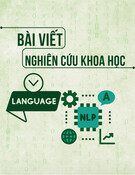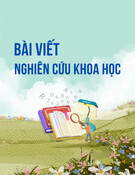
VĂN HÓA https://jst-haui.vn Tạp chí Khoa học và Công nghệ Trường Đại học Công nghiệp Hà Nội Tập 60 - Số 12 (12/2024)
120
NGÔN NG
Ữ
P
-
ISSN 1859
-
3585
E
-
ISSN 2615
-
961
9
TRANSLATION AS A PEDAGOGICAL TOOL FOR ENHANCING READING COMPREHENSION FOR NON-MAJORED STUDENTS
SỬ DỤNG PHƯƠNG PHÁP DỊCH NHƯ MỘT CÔNG CỤ SƯ PHẠM ĐỂ NÂNG CAO KHẢ NĂNG HIỂU ĐỌC CHO SINH VIÊN KHÔNG CHUYÊN Nguyen Thi Thanh Muoi1, Nguyen Thuy Trang2,* DOI: http://doi.org/10.57001/huih5804.2024.426 ABSTRACT The role of translation in language teaching and learning has been overlooked due to the negative connotations with the traditional grammar-
translation
method. However, during the past few years, many researchers recognised the importance of translation as a pedagogical tool in developing read
ing
comprehension skills. To investigate how translation enhances students' understanding of texts, vocabulary acquisition, and eng
agement in reading, the authors
have utilized a mixed-methods approach. The research was conducted on 20 non-
English majored students at Hanoi University of Industry, half in the
experimental group and half in the controlled group. The data were collected from pre- and post-
tests on reading comprehension, observations during class
hours, a questionnaire survey and interviews with randomly selected participants. This research result revealed that translat
ion facilitated learners in
comprehending terminologies and texts, and motivated them to take part in reading activities actively. Moreover, this approach helped students focus onunderstanding the content message and realize the imperfections of machine translation. Therefore, it is suggested that a proper a
mount of translation in
teaching reading can be a valuable supplement since this can enhance comprehension and foster an engaging learning environment. Keywords: Reading comprehension; translation; supplement; language acquisition. TÓM TẮT Nghiên cứu được thực hiện nhằm đánh giá hiệu quả của phương pháp đọc dịch trong việc nâng cao kỹ năng đọc hiểu của sinh viên không chuyên tại Trườ
ng
Đại học Công nghiệp Hà Nội. Để đánh giá mức độ cải thiện kỹ năng đọc hiểu của sinh viên cũng như mức độ tham gia của sinh viên, tác giả đã áp dụ
ng phương
pháp nghiên cứu hỗn hợp trên 20 sinh viên, trong đó một nửa thuộc nhóm thử nghiệm, một nửa thuộc nhóm đối chứng. Dữ liệu được thu thập từ các bài kiể
m
tra trước và sau khi áp dụng phương pháp đọc dịch, quan sát của tác giả trong giờ học và khảo sát bằng bảng hỏi. Nghiên cứu cho thấy các tín hiệu tích cự
c như
sự cải thiện trong khả năng hiểu văn bản, khả năng tiếp thu, nhớ từ vựng và thái độ hào hứng của các em với hoạt động đọc. Điều này chỉ ra rằng kết hợp đọ
c
dịch vào giảng dạy ngoại ngữ là cần thiết vì phương pháp này giúp cải thiện kỹ năng đọc hiểu của sinh viên, khuyến khích các em tham gia các hoạt động đọ
c
tích cực hơn thay vì lệ thuộc vào các công cụ hỗ trợ. Từ khóa: Đọc hiểu, đọc dịch, bổ trợ, hấp thụ ngôn ngữ. 1Hung Yen University of Technology and Education, Vietnam 2School of Language and Tourism, Hanoi University of Industry, Vietnam *Email: nguyenthuytrang9087@gmail.com Received: 01/11/2024 Revised: 20/12/2024 Accepted: 26/12/2024 1. INTRODUCTION Reading comprehension is considered an important part of language learning. It is especially true for adult learners who are required to read efficiently and quickly enough to get information or a full understanding of materials either for their careers or study purposes.

P-ISSN 1859-3585 E-ISSN 2615-9619 https://jst-haui.vn LANGUAGE - CULTURE Vol. 60 - No. 12 (Dec 2024) HaUI Journal of Science and Technology
121
At Hanoi University of Industry, non-English majored students encounter a variety of complex reading texts related to their vocational purposes that challenge their understanding and engagement. They need help in grasping strange terminologies and understanding the contents due to their low level in English. This explains why, with the availability of translating tools, especially the appearance of AI apps such as Chat GPT, learners have become highly dependent on technology when it comes to reading. This reliance is detrimental to their reading comprehension ability and overall language competency. Current approaches to teaching reading skills may not fully address the diverse needs of learners, forcing teachers to figure out innovative strategies that can enhance comprehension. Translation activities have been outlawed from language teaching for a long time. However, this denial should have addressed potential benefits translation can provide language learners with. Over the last few years, translation has started to find its place within language classrooms and this approach is now considered a useful resource to apply in learning a foreign language. Translation is proven to be effective in improving reading comprehension-especially in technical and specialized fields. When allowing students to translate texts from their native language into the target language and vise visa, teachers can encourage more profound understanding and connection with the materials. This process not only aids in vocabulary acquisition but also foster deper understanding of the reading texts. This study aimed at figuring out how the use of translation can enhance reading comprehension skills and the following are considered the research questions: • What are the problems that learners encounter related to reading comprehension? • How effectively can translation facilitate reading comprehension? • What is the attendees’ opinion towards the use of this method? 2. LITERATURE REVIEW 2.1. Reading comprehension 2.1.1. Reading comprehension and its connection to translation Reading comprehension is simply defined as the ability to read and understand the content of a text. Many authors have agreed that it is a complex activity requiring different approaches [7, 9]. According to Rushwan [16], reading comprehension in general, is the connection between translation and reading. Similarly, Sweet & Snow [17] mention it as simultaneously extracting and constructing meaning through interaction with written language. Good readers may need a lot of comprehension strategies when reading, including understanding vocabulary within reading context, skimming, scanning, making predictions, summarizing the content, making connections, visualizing and translation. Researchers argue that these strategies foster and develop learners’ meta-cognitive skills necessary for effective reading. 2.1.2. Learners’ difficulties in reading comprehension Since university students are required to read content with a high level of complexity and language-based knowledge, they need to be particularly competent in terms of both background knowledge and language. However, non-majored students often suffer from various problems when reading. Ho [6] and Pulido [14] agree that learners with limited knowledge of language struggle to comprehend the content and cannot tackle complex content in depth. They also have difficulty recalling previous information or locating proper information stated in the reading text [1]. Recent studies have pointed out different challenges of reading comprehension, including language and metalinguistic, grammar and word recognition problems, text-processing problems as well as other obstacles such as teaching methods or uninteresting contents [15]. 2.2. Translation and its role in language teaching and learning Translation first refers to a professional activity, particularly in the educational context, which transfers knowledge from one way of understanding to another. More visually, Johnson [8] describes translation as the bridge to difference. The importance of translation is confirmed in many other books. George Steiner emphasized that: "All acts of communication are acts of translation". Bonyadi [4] also states that classroom translation activities enhance interactions among teachers and students and peer-to-peer engagement. Furthermore, when learning a foreign

VĂN HÓA https://jst-haui.vn Tạp chí Khoa học và Công nghệ Trường Đại học Công nghiệp Hà Nội Tập 60 - Số 12 (12/2024)
122
NGÔN NG
Ữ
P
-
ISSN 1859
-
3585
E
-
ISSN 2615
-
961
9
language, learners often resort to translation instinctively, especially at the elementary and intermediate levels. Newmark [12] highlights that communicative translation shifts the focus from merely learning translation skills to leveraging translation as a resource. Dudley-Evans and St. John notes that when educators balance the use of translation effectively and tailor it to learners' specific needs, translation can be an effective teaching and learning strategy [5]. In his research, Widdowson [18] recognized that translation activities can facilitate comprehension of the target language by allowing learners to compare structures between their mother tongue and the target language. Leonardi [10] argues that translation is 'a sum of the four skills' with the ability to support, strengthen, and consolidate those skills and be a tool to test how effectively students can apply them. 2.3. The role of translation in reading comprehension There are compelling reasons for accepting translation, particularly when terminology is included. Instead of merely comprehending the content, this method requires learners to think critically and analyze sentence structure, grammar, and vocabulary. According to recent research from Oxford University, the translation method can enhance language acquisition by up to 30% compared to conventional reading comprehension methods. Translating specific terms into the first language can also enhance clarity, allowing learners to understand complex concepts more deeply. This method not only deepens understanding but also enriches the overall learning experience. In specific contexts such as English for Specific Purposes (ESP), understanding texts is crucial for creating a knowledge base that helps students better engage with the material. It supports vocabulary acquisition by linking new terms to familiar ones, making it easier for students to retain and apply their knowledge in context. Mahmoud [11] argues that translation can enhance comprehension by encouraging students to read passages carefully at the word, sentence, and text levels. However, there are several considerations to keep in mind when incorporating translation into language teaching. Mahmoud [11] emphasizes the importance of carefully considering specific learning objectives, proficiency levels, and potential challenges associated with different task types when introducing translation tasks in the EFL classroom. Furthermore, he suggests that teachers should engage learners in meaningful activities tailored to their individual needs and preferences to best use this method. Current research suggests that modern translation activities differ significantly from the traditional grammar-translation method, characterized by non-interactive, teacher-centered classrooms with limited activities beyond the translation of uninteresting and irrelevant texts [11]. 3. METHODOLOGY 20 non-majored students (18 girls and 2 boys) from Hanoi University of Industry participated in this 10-week experiment, which was integrated into their regular course schedule. Every week, they attended two 50-minute English classes. The participants used the same standard coursebook aligned with their major, which supported the consistency of the experiment. They had varied levels of language proficiency, allowing the authors to assess their overall effectiveness of using translation to improve reading comprehension. Furthermore, all participants had completed at least one term of English language at Hanoi University of Industry to ensure that they possessed basic reading skills and could provide reliable responses to the survey questions. The experiment was conducted over a 10-week period, beginning with a pre-test in Week 1 to assess the participants’ baseline reading comprehension. The test consisted of four reading passages relevant to the participants' field of study. Each passage contained five questions designed to evaluate students' reading comprehension skills. Based on the results, the 20 students were divided into two groups: the experimental group, which received additional translation tasks, and the control group, which did not. Both groups received the same classroom instruction throughout the semester. Every week, the experimental group completed translation exercises that involved translating texts from English to Vietnamese (or vice versa), while the control group only engaged in regular reading comprehension activities. In Week 10, a post-test (similar to the pre-test) was administered to both groups to evaluate improvements in reading comprehension. Surveys, interviews, and test data were collected to analyse the effectiveness of translation tasks on reading skills.

P-ISSN 1859-3585 E-ISSN 2615-9619 https://jst-haui.vn LANGUAGE - CULTURE Vol. 60 - No. 12 (Dec 2024) HaUI Journal of Science and Technology
123
Additionally, the researchers used questionnaires, interviews, and tests as the main sources to collect data. The questionnaires provided quantitative data by assessing participants' attitudes, experiences, and their perceptions about the use of translation in improving reading comprehension. Interviews with randomly selected students offered qualitative insights, allowing the researchers to gather in-depth feedback and explore participants' personal views and challenges in more detail. This mix approach ensured that data collection was not only quantitative but also qualitatively valuable. 4. RESULTS AND DISCUSSION 4.1. Analysis of pre-and post-test results Figure 1. Raw marks collected from experimental group Figure 2. Raw marks collected from control group The pre-test scores ranged from 1 to 8, divided into four categories of mark: 1-2, 3-4, 5-6, and 7-8 with a completely uniform distribution of scores to each student group. The majority of students getting marks 3 to 6 (four students got marks 3-4 and four students got marks 5-6 in each group). Both groups have one student in each category for the lowest and second-highest scores. The data reveals an overall positive shift in reading scores for both groups. However, after the treatment, group 1 (experimental group) appeared to have much better improvement in terms of marks in comparison with that of group 2 (control group). While the minimum score of group 1 increased to 3-4, that of group 2 remained unchanged. Similarly, group 1 was outperforming group 2 with an improvement of mark in others categories. In particular, the number of students receiving marks 7-8 increased to three students, surpassing that of group 2 with only one student. This suggests Group 1 may be making quicker progress in developing their reading comprehension skills. In conclusion, the improved performance of group 1 suggests that translation offers significant advantages for enhancing reading comprehension. 4.2. Qualitative insights from student surveys and interviews 4.2.1. Difficulties in learning reading comprehension Figure 3. Students’ difficulties in learning reading comprehension This chart revealed the primary challenges students faced in reading practice. The most common obstacle, reported by 100% of students, was grammar and vocabulary recognition problems. Limited language and metalinguistic knowledge was also a huge challenge for students when encountering a complex reading text. Problems with teaching methods and uninterested reading content affected 60% and 40% of students, respectively. The findings highlighted the areas of suitability when using translation in reading comprehension. Translation was proved to be particularly effective in helping students overcome challenges related to grammar and vocabulary recognition, which were reported as the most common obstacles. By translating texts, students had the opportunity to engage deeply with the language, reinforcing their understanding of sentence structure, vocabulary, and grammar in context. This method is also useful in addressing students' metalinguistic knowledge, as it encourages them to analyze language differences and similarities between their native language and English. Moreover, translation tasks were shown to be beneficial for complex reading texts, enabling students to better comprehend difficult material.

VĂN HÓA https://jst-haui.vn Tạp chí Khoa học và Công nghệ Trường Đại học Công nghiệp Hà Nội Tập 60 - Số 12 (12/2024)
124
NGÔN NG
Ữ
P
-
ISSN 1859
-
3585
E
-
ISSN 2615
-
961
9
4.2.2. Students’ attitudes towards the effectiveness of incorporating translation into language learning The questionnaire used in this study was designed by the researchers specifically for this experiment to assess students' attitudes toward the effectiveness of translation in improving reading comprehension. The questions were based on established theories of language learning and translation pedagogy, drawing inspiration from previous studies that investigated the role of translation in language acquisition and comprehension [11]. To make sure that all students understand the content precisely, the authors provided the information both in English and Vietnamese. Table 1. Students’ attitudes towards the effectiveness of translation Agreement Choices Strongly disagree
Disagree
Don’t know
Agree
Strongly Agree Helping me
understand the words
in context 0% 0% 0% 70% 30% Helping me remember the meaning of the words deeper and longer 0% 0% 10% 40% 50% Helping me understand the use of different grammar structures better 0% 0% 10% 60% 30% Improving my critical thinking and analytical skills 0% 10% 20% 50% 20% Improving my ability to guess the meaning of words in context 0% 10% 20% 50% 20% Improving the ability
to understand general
ideas of reading texts
10% 10% 20% 40% 20% Helping me understand complex concepts more deeply
0% 0% 10% 50% 40% Encouraging me to read passages carefully at the word, sentence, and text levels 0% 0% 10% 20% 70% Making reading less stressful and more rewarding 10% 0% 30% 40% 20% Improving my prediction and inference skills 10% 10% 20% 40% 20% Helping me feel more confident in my reading competence 0% 10% 20% 40% 30% The results of the questionnaire survey proved that the use of translation as a pedagogical tool demonstrated its potential to not only improve linguistic skills but also increase motivation, as students developed greater confidence in their reading abilities. Overall, participants expressed strongly favourable attitudes towards using translation to improve reading comprehension. All students reported that translation tasks helped them better understand the words in context, and nine out of ten indicated they could retain the words deeper for a longer duration thanks to this method. Similarly, 90% of the participants confirmed that translation motivated them to spend more time on reading passages and assisted them in deeper comprehension of complex texts and grammar structures. A majority of students (70%) reported increased confidence and 60% of them felt a sense of accomplishment when doing reading comprehension tasks after the treatment. This revealed a highly positive impact of translation on participants’ confidence and motivation. Many students felt that translation tasks contributed to their development in critical thinking, analytical, inference and prediction skills. This suggested that the integration of translation in reading activities not only aids comprehension but also encourages deeper analytical engagement with texts. Thus, translation can be a suitable method to enhance reading comprehension, especially for students facing language-related difficulties. In short, this report suggests that translation is a valuable tool for enhancing various aspects of reading comprehension skills, fostering motivation, confidence, comprehension, and the acquisition of language. 4.3. Insights from class observation and interviews The data from classroom observations and interviews provided valuable qualitative insights into how

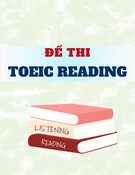

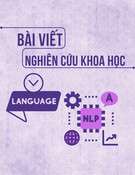


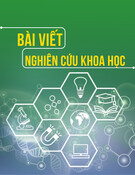
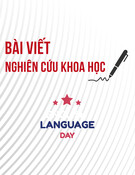
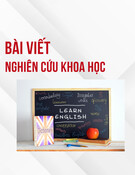
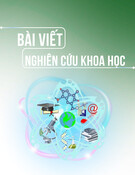
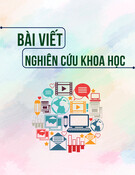
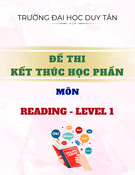
![Đề cương môn Tiếng Anh 1 [Chuẩn Nhất/Mới Nhất]](https://cdn.tailieu.vn/images/document/thumbnail/2025/20251130/cubabep141@gmail.com/135x160/51711764555685.jpg)


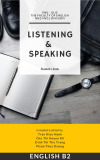
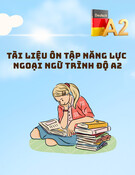

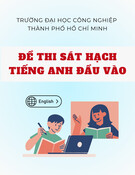
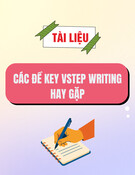
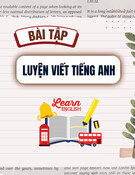
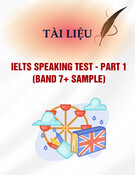
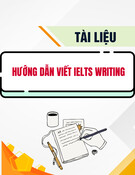
![Mẫu thư Tiếng Anh: Tài liệu [Mô tả chi tiết hơn về loại tài liệu hoặc mục đích sử dụng]](https://cdn.tailieu.vn/images/document/thumbnail/2025/20250814/vinhsannguyenphuc@gmail.com/135x160/71321755225259.jpg)
